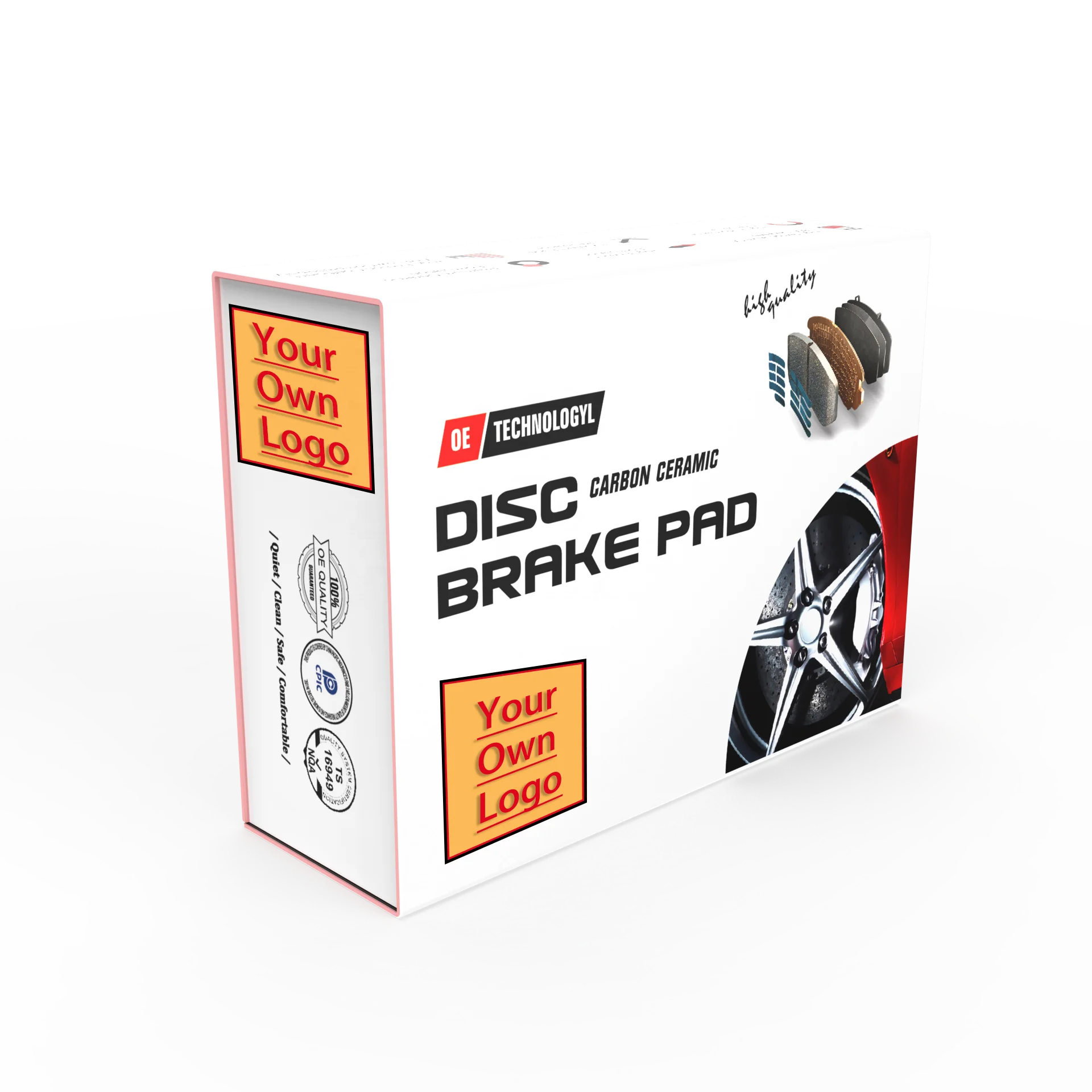Understanding when to replace automotive brake pads is crucial for vehicle safety and optimal performance. These essential components work tirelessly to bring your vehicle to a safe stop, but they gradually wear down with each use. Recognizing the warning signs and following proper replacement schedules can prevent costly repairs, ensure passenger safety, and maintain your vehicle's braking efficiency. Most drivers overlook the importance of timely brake pad replacement until they experience complete brake failure or hear concerning noises during braking operations.

Professional mechanics recommend monitoring brake pad thickness regularly, as worn pads can compromise your vehicle's stopping power and damage other braking system components. The frequency of replacement varies significantly based on driving conditions, vehicle type, and driving habits. Urban drivers who frequently encounter stop-and-go traffic typically require more frequent replacements compared to highway drivers who use their brakes less aggressively.
Signs Your Automotive Brake Pads Need Replacement
Audible Warning Signals
The most common indication that automotive brake pads require replacement is the distinctive squealing or grinding sound during braking. Modern brake pads incorporate built-in wear indicators that create a metallic squealing noise when the friction material reaches minimum thickness. This engineered warning system alerts drivers before complete pad failure occurs, providing adequate time for scheduled replacement.
Grinding noises represent a more serious concern, indicating that the friction material has worn completely away and metal backing plates are contacting the brake rotors. This metal-on-metal contact can cause severe damage to brake rotors, requiring expensive repairs beyond simple pad replacement. Immediate attention is necessary when grinding sounds occur during braking operations.
Visual Inspection Indicators
Regular visual inspection through wheel spokes allows drivers to monitor brake pad thickness without removing wheels. Healthy brake pads should measure at least one-quarter inch thick, while pads approaching replacement typically show three millimeters or less of friction material remaining. Many automotive brake pads feature wear indicator grooves that disappear as the pad material wears down.
Professional technicians use specialized measuring tools to assess pad thickness accurately, but experienced drivers can perform basic visual assessments during routine vehicle maintenance. Uneven wear patterns may indicate alignment issues, stuck calipers, or other brake system problems requiring professional diagnosis and correction.
Factors Affecting Brake Pad Replacement Frequency
Driving Conditions and Habits
City driving with frequent stops significantly increases brake pad wear compared to highway driving at consistent speeds. Heavy traffic conditions force drivers to use their brakes more frequently, generating additional heat and friction that accelerates pad deterioration. Aggressive braking behaviors, such as hard stops and late braking, also contribute to premature wear of automotive brake pads.
Mountain driving presents unique challenges due to extended downhill braking periods that generate excessive heat buildup. Drivers in mountainous regions often experience faster brake pad wear and may need to employ engine braking techniques to preserve their braking components. Commercial vehicles and those frequently towing heavy loads also require more frequent brake pad replacements due to increased stress on the braking system.
Vehicle Type and Weight Considerations
Heavier vehicles naturally place greater demands on their braking systems, resulting in faster brake pad wear rates. Large SUVs, trucks, and commercial vehicles typically require more frequent brake pad replacements compared to compact cars due to increased kinetic energy that must be dissipated during braking operations. Vehicle weight directly correlates with the force required to achieve effective stopping power.
Performance vehicles with high-speed capabilities often utilize specialized brake pad compounds designed for extreme temperatures and repeated heavy braking. These performance-oriented pads may require more frequent replacement but provide superior stopping power and heat resistance compared to standard passenger car brake pads.
Brake Pad Material Types and Longevity
Organic Brake Pad Compounds
Organic automotive brake pads, also known as non-asbestos organic (NAO) pads, utilize natural materials like rubber, glass, and Kevlar fibers bonded with resin. These pads offer quiet operation and gentle contact with brake rotors, making them ideal for daily driving applications. However, organic compounds typically provide shorter service life and may experience reduced performance in extreme temperature conditions.
Most economy vehicles come equipped with organic brake pads from the factory due to their cost-effectiveness and acceptable performance for normal driving conditions. These pads generate minimal brake dust and operate smoothly throughout their service life, but require more frequent replacement compared to alternative materials.
Semi-Metallic and Ceramic Options
Semi-metallic brake pads incorporate steel wool, iron powder, and copper fibers to enhance heat dissipation and durability. These pads typically last longer than organic alternatives and provide consistent performance across various temperature ranges. However, semi-metallic compounds may produce more brake dust and create additional wear on brake rotors over time.
Ceramic brake pads represent the premium option, utilizing ceramic fibers and copper strands to deliver exceptional longevity and performance. These advanced compounds operate quietly, produce minimal dust, and maintain consistent friction characteristics throughout their extended service life. While ceramic pads require higher initial investment, their superior durability often results in lower long-term costs for many drivers.
Professional Inspection and Replacement Procedures
Diagnostic Assessment Techniques
Professional brake system inspections involve comprehensive evaluation of all braking components, including pad thickness measurements, rotor condition assessment, and brake fluid analysis. Qualified technicians use precision measuring instruments to determine exact pad thickness and identify potential safety concerns before they become critical failures.
Advanced diagnostic equipment can detect brake system problems that may not be apparent during visual inspections. Professional assessment includes checking brake line integrity, caliper operation, and master cylinder function to ensure complete system reliability after brake pad replacement.
Installation Best Practices
Proper brake pad installation requires specific procedures to ensure optimal performance and safety. Professional technicians follow manufacturer specifications for torque settings, break-in procedures, and system bleeding to maintain peak braking efficiency. Incorrect installation can result in premature wear, reduced stopping power, or complete brake system failure.
Quality brake pad replacement includes rotor surface preparation, caliper cleaning, and hardware lubrication to prevent noise and ensure smooth operation. Many shops also perform brake system flushing during pad replacement to remove contaminated brake fluid and maintain hydraulic system integrity.
Cost Considerations and Maintenance Planning
Budgeting for Brake Pad Replacement
Brake pad replacement costs vary significantly based on vehicle type, pad material selection, and regional labor rates. Economy vehicles typically require less expensive pads and simpler installation procedures, while luxury or performance vehicles may need specialized compounds and additional labor time. Planning for regular brake maintenance helps avoid emergency repairs and associated premium pricing.
Many automotive service centers offer brake inspection services to help vehicle owners plan replacement timing and budget accordingly. Early detection of brake pad wear allows for scheduled maintenance during convenient times rather than emergency roadside failures that require immediate attention.
Long-Term Maintenance Strategies
Developing a comprehensive brake maintenance schedule includes regular inspections, fluid changes, and proactive component replacement. Vehicle owners who maintain detailed service records can identify wear patterns and optimize replacement intervals based on their specific driving conditions and habits.
Investing in higher-quality brake pad materials often results in extended service intervals and improved overall performance. While premium pads require higher initial costs, their enhanced durability and performance characteristics frequently justify the additional expense through reduced replacement frequency and superior safety margins.
FAQ
How often should automotive brake pads be replaced?
Most automotive brake pads require replacement every 25,000 to 70,000 miles, depending on driving conditions, vehicle type, and pad material. City drivers with frequent stop-and-go traffic typically need replacements every 25,000 to 40,000 miles, while highway drivers may extend intervals to 50,000 to 70,000 miles. Regular inspections help determine optimal replacement timing for individual driving patterns.
Can I replace brake pads myself or should I use a professional?
While mechanically inclined individuals can replace brake pads with proper tools and knowledge, professional installation ensures correct procedures and safety compliance. Brake system work involves critical safety components that require precise installation and proper bleeding procedures. Professional technicians have specialized equipment and experience to identify potential problems and ensure optimal performance after replacement.
What happens if I delay brake pad replacement too long?
Delaying brake pad replacement beyond recommended intervals can result in rotor damage, reduced stopping power, and potential brake system failure. Worn pads allow metal backing plates to contact rotors, creating expensive damage that requires rotor replacement or resurfacing. Severely worn brake pads compromise vehicle safety and may lead to accidents due to insufficient stopping power.
Do all four brake pads need replacement at the same time?
Front and rear brake pads typically wear at different rates, with front pads usually requiring more frequent replacement due to increased braking load. However, pads on the same axle should be replaced simultaneously to maintain balanced braking performance. Most manufacturers recommend replacing brake pads in axle sets rather than individually to ensure consistent friction characteristics and optimal vehicle control.

